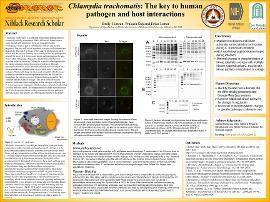| dc.contributor.advisor | Lutter, Erika Ildiko | |
| dc.contributor.author | Gietzen, Emily Marie | |
| dc.contributor.author | Sah, Prakash | |
| dc.contributor.author | Lutter, Erika Ildiko | |
| dc.contributor.other | Wentz Research Scholars | |
| dc.date.accessioned | 2019-05-08T13:02:44Z | |
| dc.date.available | 2019-05-08T13:02:44Z | |
| dc.date.issued | 2019-04-26 | |
| dc.identifier | oksd_Wentz_2019_gietzen | |
| dc.identifier.citation | Gietzen, E. M., Sah, P., & Lutter, E. I. (2019, April 26). Chlamydia trachomatis: The key to human pathogen and host interaction. Poster session presented at the Oklahoma State University Wentz Research Scholars Symposium, Stillwater, OK. | |
| dc.identifier.uri | https://hdl.handle.net/11244/319590 | |
| dc.description.abstract | Chlamydia trachomatis is an obligate intracellular pathogen that is commonly sexually transmitted. While Chlamydia infections are easily treated with antibiotics, there are long-term health consequences such as pelvic inflammatory disease and ectopic pregnancy that may still occur in patients who received treatment and cleared the infection. The focus of this study is on these long-term effects and the reasons that they are occurring. Once the pathogen has entered the host cell, it forms an inclusion and manipulates the host from within. This project focused on the host kinases that were recruited to the inclusion by Chlamydia as well as what happened to the kinase substrates during the course of infection. Through immunofluorescence, it was determined that there are multiple host kinases and kinase substrates that are recruited to the Chlamydia inclusion. Western blotting was then used to identify which kinases and kinase substrates were being manipulated by the Chlamydia throughout the infection process. Western blotting identified PKA substrate phosphorylation changes. The other substrates tested, however, indicated minimal phosphorylation changes indicating that C. trachomatis has a strategy in which it selects certain host substrates to utilize in the inclusion. The manipulation of certain host kinases by the C. trachomatis inclusion is a key component in host-pathogen interactions and may lead to novel therapeutic targets in the future. | |
| dc.description.sponsorship | Lew Wentz Foundation | |
| dc.format | application/pdf | |
| dc.language | en_US | |
| dc.publisher | Oklahoma State University | |
| dc.rights | The author(s) retain the copyright or have the right to deposit the item giving the Oklahoma State University Library a limited, non-exclusive right to share this material in its institutional repository. Contact Digital Resources and Discovery Services at lib-dls@okstate.edu or 405-744-9161 for the permission policy on the use, reproduction or distribution of this material. | |
| dc.title | Chlamydia trachomatis: The key to human pathogen and host interaction | |
| osu.filename | oksd_Wentz_2019_gietzen.pdf | |
| dc.description.department | Microbiology and Molecular Genetics | |
| dc.type.genre | Presentation | |
| dc.type.material | Text | |
| dc.subject.keywords | chlamydia trachomatis | |
| dc.subject.keywords | intracellular pathogen | |
| dc.subject.keywords | chlamydia | |
